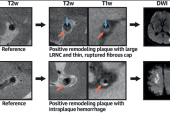Predictors of AF May Help Guide Care After Stroke of Unknown Cause
Older age and higher NT-proBNP point to higher AF risk, making the case for long-term cardiac monitoring in select patients.

Certain patients who have an embolic stroke of undetermined source (ESUS) are particularly vulnerable to developing atrial fibrillation (AF) after their event, according to an analysis of data from the RE-SPECT ESUS study. Researchers say knowledge of these risk factors, especially older age and higher baseline NT-proBNP level, may help pinpoint who’s most likely to benefit from closer surveillance.
Just 7.5% of RE-SPECT ESUS trial participants were identified as having AF over a median follow-up of 19 months, but importantly the arrhythmia appeared to increase their risk of recurrent stroke, Maria Cecilia Bahit, MD (INECO Neurociencias Rosario, Argentina), and colleagues report in Circulation.
In fact, AF prevalence was lower in their data set, where the arrhythmias were identified during standard care, than it has been in studies with continuous cardiac monitoring, where AF was detected in 10% of ESUS patients within 6 months and in 30% within 3 years. Such patients might benefit from oral anticoagulation as secondary prevention, they suggest. This stands in contrast to results from the main RE-SPECT ESUS trial, as well as NAVIGATE ESUS, which failed to show a reduction in recurrent stroke with oral anticoagulants when given broadly.
“This study provides a way to identify patients who may have higher risk for atrial fibrillation and who may benefit from prolonged cardiac monitoring,” whether that’s through an implanted device or some other method, Bahit told TCTMD. The investigators say that better understanding of best strategies for monitoring could further “the goals of timely detection of AF and prevention of related stroke.”
George Ntaios, MD, PhD (University of Thessaly, Larissa, Greece), commenting on the findings for TCTMD, confirmed that there isn’t a strong consensus about the optimal strategy for cardiac monitoring in ESUS patients. At a minimum, it lasts for 24 hours and some scientific bodies advocate for at least 72 hours, he added.
Yet, as of now, only a small segment of patients with ESUS receive prolonged monitoring, “mainly due to limited availability of technical and human resources, as well as due to the considerable cost for some of the available monitoring options,” Ntaios wrote in an email.
Thus, he noted, this analysis explores a clinically relevant issue: how to identify the best candidates.
AF in RE-SPECT ESUS
Using data from RE-SPECT ESUS, Bahit et al looked at AF development among 5,390 patients. AF wasn’t systematically identified as part of the main study; rather, it was reported as an adverse event, listed on case reports for recurrent stroke, or found by cardiac monitoring during standard care.
The patients who developed AF tended to be older, female, and to have histories of CAD, hypertension, or renal impairment. They also had higher CHA2DS2-VASc and HAVOC scores than those who didn’t experience AF.
On multivariable analysis, several factors independently predicted AF occurrence. Older age (OR per 10-year increase 1.99; 95% CI 1.78-2.23), hypertension (OR 1.36; 95% CI 1.03-1.79), and body mass index (OR per 5-unit increase 1.29; 95% CI 1.16-1.43) indicated higher risk, whereas diabetes was linked to lower risk (OR 0.74; 95% CI 0.56-0.96). Additionally, higher HAVOC and CHA2DS2-VASc scores were tied to greater likelihood of AF.
Twenty percent of the cohort had their NT-proBNP level measured at baseline (median 1,010 vs 460 pg/mL in patients with vs without AF; P < 0.001), as this wasn’t mandated by trial protocol. A sensitivity analysis restricted to these patients showed the only independent predictors of AF to be older age (OR per 10 years 1.32; 95% CI 1.32-1.08-1.66) and higher NT-proBNP (OR per 1-unit increase on log scale 1.74; 95% CI 1.40-2.16).
The finding “suggests that this biomarker may be helpful to identify patients with ESUS who would have the highest yield from extended cardiac monitoring to detect AF,” Bahit and colleagues write. Currently, NT-proBNP measurement isn’t routine, she noted to TCTMD, adding that this secondary analysis is merely hypothesis-generating.
For the ESUS patients, AF development was accompanied by adverse outcomes: the annualized rate of recurrent stroke was nearly twice as high in those with the arrhythmia (7.0% vs 4.2% without AF; P = 0.002). Stroke risk trended higher, though not significantly so, among patients with more of the risk factors identified in the RE-SPECT ESUS data. In the highest tertile of risk, dabigatran was more effective than aspirin, but overall there was no interaction between study drug (dabigatran or aspirin) and stroke by AF risk.
“I think these are important findings that may help use a resource, such as prolonged cardiac monitoring, in a better way” by targeting the right patients, Bahit said. Next up, they need to validate their findings in other patient populations and evaluate whether this use of monitoring, by impacting care when AF is found, indeed improves outcomes.
Ntaios observed that there have been other attempts to stratify ESUS patients by their risk of AF, among them the AF-ESUS score that he helped develop. He agreed that the question is what to do with that information.
“For the moment, the role of extended cardiac monitoring to reduce stroke risk is not established,” he stressed, pointing to doubts raised by the LOOP trial. LOOP, published a few months back in the Lancet, showed that screening with an implantable loop recorder more than doubled AF detection and anticoagulant use but had no effect on stroke. Nor is there any evidence to support stroke reduction with a strategy of AF detection based on NT-proBNP, he added.
For Ntaios, another outstanding research question worth exploring is “whether we need to anticoagulate subclinical episodes of atrial fibrillation in patients with ESUS, especially those episodes who have short duration and occur distally from the time of stroke.”
Caitlin E. Cox is News Editor of TCTMD and Associate Director, Editorial Content at the Cardiovascular Research Foundation. She produces the…
Read Full BioSources
Bahit MC, Sacco RL, Easton D, et al. Predictors of development of atrial fibrillation in patients with embolic stroke Of undetermined source: an analysis of the RE-SPECT ESUS trial. Circulation. 2021;Epub ahead of print.
Disclosures
- The RE-SPECT ESUS trial was funded by Boehringer Ingelheim.
- Bahit reports honoraria as consultant/advisory board/speaker from Merck, Pfizer, and Vifor Pharma, as well as national coordinator for clinical trials from Vifor Pharma and CSL Behring.
- Ntaios was the principal investigator of the AF-ESUS investigator-initiated study which developed the AF-ESUS score. This study was supported with funding from BMS, Pfizer, and the Swiss Cardiology Foundation.





Comments